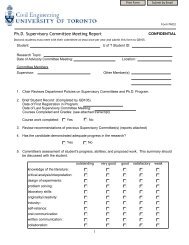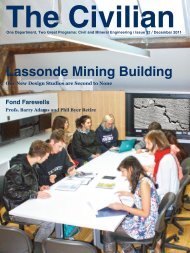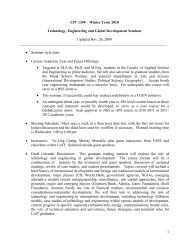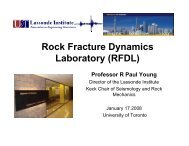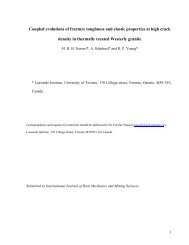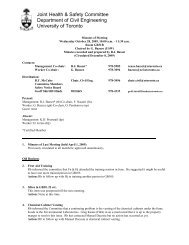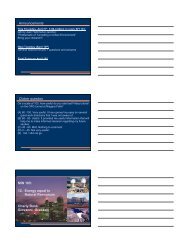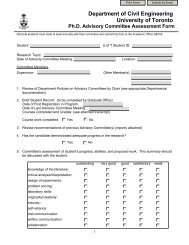Mineral diagnostic properties - Civil Engineering
Mineral diagnostic properties - Civil Engineering
Mineral diagnostic properties - Civil Engineering
You also want an ePaper? Increase the reach of your titles
YUMPU automatically turns print PDFs into web optimized ePapers that Google loves.
notes on mineral identification (Charly Bank, UofT dept of geology) 2<br />
cleavage/fracture: some minerals split along smooth planes (cleavage), while others break<br />
along irregular surfaces (fracture). Cleavage is described by a number (1, 2, 3, 4, 6),<br />
an angle (larger - equal - smaller 90 ◦ ), and a quality (excellent, good, poor), see Fig 3.<br />
Cleavage is a very useful property (e.g., cubic cleavage in halite, rhombic cleavage in<br />
calcite). Cleavage is an easy way to distinguish between pyroxenes and amphiboles (2<br />
cleavages at 90 ◦ or 120 ◦ ). Fracture ranges in type and quality; two distinctive types are<br />
conchoidal (shell-shaped, like quartz) and hackly (like torn metal). To observe cleavage,<br />
turn the mineral until you see a flash of reflected light from the specimen (Fig 3).<br />
Fig 3: observation and description of cleavage<br />
colour/streak: Note that colour is <strong>diagnostic</strong> only for very few minerals. Streak is the colour<br />
of a mineral in powdered form, it tends to be more uniform (e.g., black streak of galena).<br />
lustre: defines how light is reflected and refracted by a mineral. Some terms to describe<br />
lustre (and examples) are:<br />
• metallic: bright (galena), dull (magnetite)<br />
• non-metallic: brilliant (diamond), glassy (quartz), greasy (massive serpentine),<br />
pearly (talc), silky (asbestos), dull (kaolinite)<br />
density: Opaque metallic minerals (like pyrite or galena) tend to be denser than non-metallic<br />
ones (like quartz or feldspar). Departures from this general rule may be <strong>diagnostic</strong> (e.g.,<br />
barite).<br />
tenacity: or how minerals break. Many minerals are brittle, that is they will break into<br />
powder (quartz, feldspar, halite). Elastic minerals will bend and spring back (e.g.,<br />
mica), while malleable can be hammered flat (e.g., copper).<br />
unusual <strong>properties</strong>: Halite (rock salt) tastes salty. Carbonate minerals will evernesc (fizz<br />
when acid is dropped on). Always handle acid carefully, and blot off with paper towel!<br />
A few minerals are magnetic (e.g., pyrrhotite vs. pyrite, magnetite vs. chromite).



